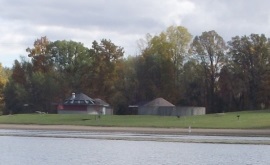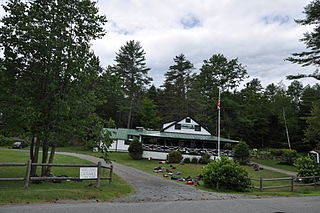Scouting in Florida is composed of Boy Scouts of America (BSA) and Girl Scouts USA (GSUSA) local councils in Florida. Scouting in Florida has a long history, from the 1910s to the present day, serving thousands of youth in programs that suit the environment in which they live.

Founded in 1885 by Sumner F. Dudley, Camp Dudley is the oldest continually running boys camp in the United States. It is located in Westport, New York, on the shores of Lake Champlain. In 1993, it was included within the Camp Dudley Road Historic District when listed on the National Register of Historic Places.

Bald Mountain State Recreation Area is a 4,637-acre (1,877 ha) state park located near Lake Orion, Michigan off M-24. It consists of some of the most rugged terrain in southeastern Michigan. The recreation area is composed of a North Unit and a South Unit, which are not contiguous. The South Unit itself includes two parts separated by M-24, but the section west of M-24 has no recreational facilities or trails and is primarily undeveloped forest and grassy plains segmented by a few through-roads.

Scenic State Park is a Minnesota state park near Bigfork in Itasca County. It encompasses 3,936 acres (1,593 ha) of virgin pine forests that surround Sandwick Lake and Coon Lake. It also includes portions of Lake of the Isles, Tell Lake, Cedar Lake, and Pine Lake. Established in 1921, the Ojibwe tribe had previously used the area for hunting. The park has places for camping, hiking, swimming, fishing, and canoeing.

Lake Shetek State Park is a state park of Minnesota, United States, on Lake Shetek, which is the largest lake in southwestern Minnesota and the headwaters of the Des Moines River. It is most popular for water recreation and camping. However the park also contains historical resources related to the Dakota War of 1862, including an original log cabin and a monument to 15 white settlers killed there and at nearby Slaughter Slough on August 20, 1862.

Lake Lashaway is a 293-acre (1.19 km2) pond located near the East Brookfield and North Brookfield, Massachusetts town line. The Lake Lashaway Community Association’s website is www.LakeLashaway.org. The town line cuts the lake approximately in half. The lake lies just to the north of state Route 9 as it passes through East Brookfield.

YMCA Camp Fitch is a year-round camp in North Springfield, Pennsylvania, owned and operated by the YMCA of Youngstown, Ohio. Prior to 1914, all summer camps operated by the YMCA of Youngstown were experimental and temporary in nature. Since its founding in 1914, Camp Fitch has hosted campers every year to date. Originally a program of the YMCA's downtown branch, Camp Fitch now exists as a YMCA branch owned by the YMCA of Youngstown.

Backbone State Park is Iowa's oldest state park, dedicated in 1919. Located in the valley of the Maquoketa River, it is approximately three miles (5 km) south of Strawberry Point in Delaware County. It is named for a narrow and steep ridge of bedrock carved by a loop of the Maquoketa River originally known as the Devil's Backbone. The initial 1,200 acres (490 ha) were donated by E.M. Carr of Lamont, Iowa. Backbone Lake Dam, a relatively low dam built by the Civilian Conservation Corps (CCC) in the 1930s, created Backbone Lake. The CCC constructed a majority of trails and buildings which make up the park.

Hedges Pond is a 26-acre (110,000 m2) pond in the Cedarville section of Plymouth, Massachusetts with access from Hedges Pond Rd. The pond is located more than one mile (1.6 km) north of Cedarville's business district past the Route 3 underpass, southeast of Black Jimmy Pond, and east of Little Herring Pond. Hedges Pond has no private residences on its shores.

The St. Methodios Faith and Heritage Center is a 223-acre (90 ha) camp run by the Greek Orthodox Metropolis of Boston and located in the town of Hopkinton, New Hampshire near the village of Contoocook. The site occupies the former village of Cloughville and had previously been home to Camp Merrimac.

Coolidge State Park is a Vermont State Park located in Plymouth, Vermont, United States. The park is named after Calvin Coolidge, the 30th President of the United States, who was born and raised in Plymouth and is buried there as well. It is the primary recreational center for Calvin Coolidge State Forest, the largest state forest in Vermont. The park's facilities, built by the Civilian Conservation Corps (CCC) in the 1930s, are listed on the National Register of Historic Places.

Pinewoods Camp is a traditional dance and music camp located on 31 acres (13 ha) of woodland between Long Pond and Round Pond in Plymouth, Massachusetts. It is the oldest continuously run folk dance camp in the U.S., and is arguably the most popular and well-known camp of its type.

Camp Wekeela is a 60-acre sleep-away summer camp in Maine with an estimated 300 campers and 135 employees each summer. It is a traditional resident summer camp for boys and girls ages 7–16, in season from June to August.

Kelly's Camp is a small district of vacation cabins on the west shore of Lake McDonald in Glacier National Park, Montana, USA. Kelly's Camp consists of twelve log buildings along the western shore of the lake. The structures were notable for being one of the most extensive summer cabin enclaves remaining in the park. Early reports following the advance of the Howe Ridge Fire on August 12, 2018 are that nine or ten structures have been destroyed.
The Alice Beck Cabin, also known as the John T. Robinson Cabin, is a recreational cabin on the eastern shore of Lake McDonald in Glacier National Park, Montana. The cabin was built around the year 1910, which was the same time that a number of other summer camps were built, and was also prior to the establishment of the park itself. Once the park was designated, the cabin has remained as a private inholding.

The Rockywold–Deephaven Camps (RDC) is a historic family summer camp on Squam Lake in Holderness, New Hampshire. Now operated as a single facility, the camp began life as two adjacent camps. Rockywold Camp was established in 1901 by Mary Alice Armstrong and Deephaven in 1897 by Alice Mabel Bacon. Since 1918 the camps have been under combined administration, first under control of Mrs. Armstrong and the Howe family, and now under an organization owned primarily by the camp's returning guests. The camps have been a major influence on the development of Squam Lake as a summer destination, with many of its early campers returning to the lake for many years. The camp grounds and facilities have been listed on the National Register of Historic Places.

Bearnstow is a summer camp on Parker Pond in Mount Vernon, Maine. The camp offers weeklong and day programs for adults and children, with an emphasis on appreciation of nature through the arts and sciences. Founded in 1946, the camp occupies 65 acres (26 ha) on the east side of the pond, and is centered on the former Spruce Point Camps, whose facilities, built in the 1920s and 1930s, are listed on the National Register of Historic Places.

Aloha Horizons Camp is a summer camp for boys and girls on Lake Fairlee in West Fairlee, Vermont. Opened in 1921 as Camp Wyoda, its property was acquired by the Aloha Foundation in 1997, and is now operated by that organization as a day camp for local children and vacationers staying in the area. Camp is divided into three two-week sessions; activities include water sports, land sports, and arts and crafts. The camp property, organized around a former farmstead, was listed on the National Register of Historic Places in 2003 for its well-kept collection of surviving early camp architecture.

Lanakila Camp is a private summer camp for boys on Lake Morey in Fairlee, Vermont. Founded in 1922 on the grounds of a 19th-century farm property, it is one of the state's older organized camps, with a significant number of period buildings in the Adirondack rustic style. The camp offers an array of outdoor activities, including water and field sports and hiking, and indoor arts and crafts programs, all generally infused with an educational purpose. It has a full 7 and a half week session, as well as two three-week sessions, typically running from late June to mid-August. During the off-season, its facilities are used as the Hulbert Outdoor Center, an educational center for adults, children, school groups and special events. The camp property was listed on the National Register of Historic Places in 2003.
Camp Marbury was a summer camp for girls on Lake Champlain in Ferrisburgh, Vermont. Founded in 1921, the family-run camp operated until 1942, when it closed due to logistical difficulties associated with World War II. The camp property is listed on the National Register of Historic Places.




















